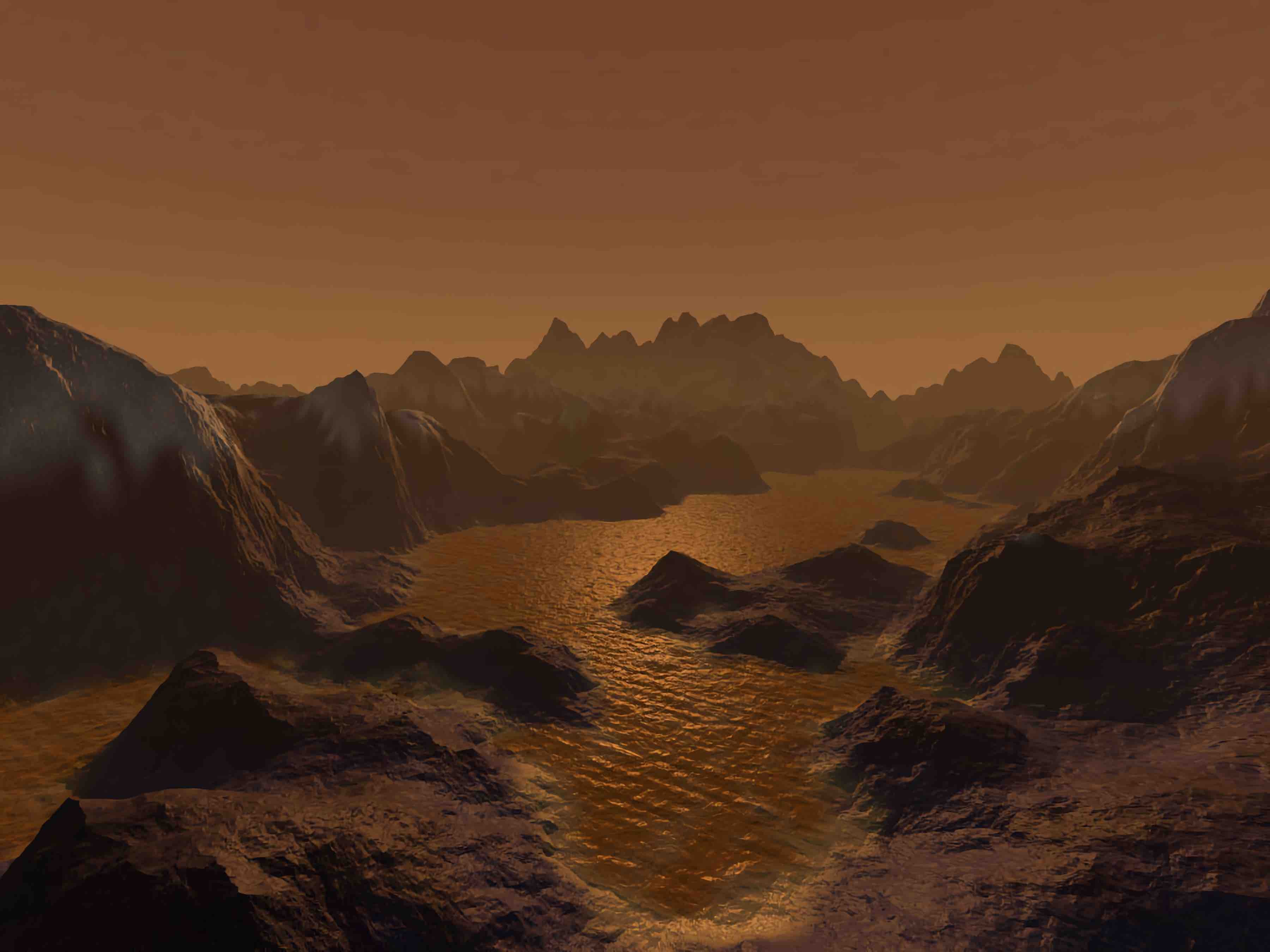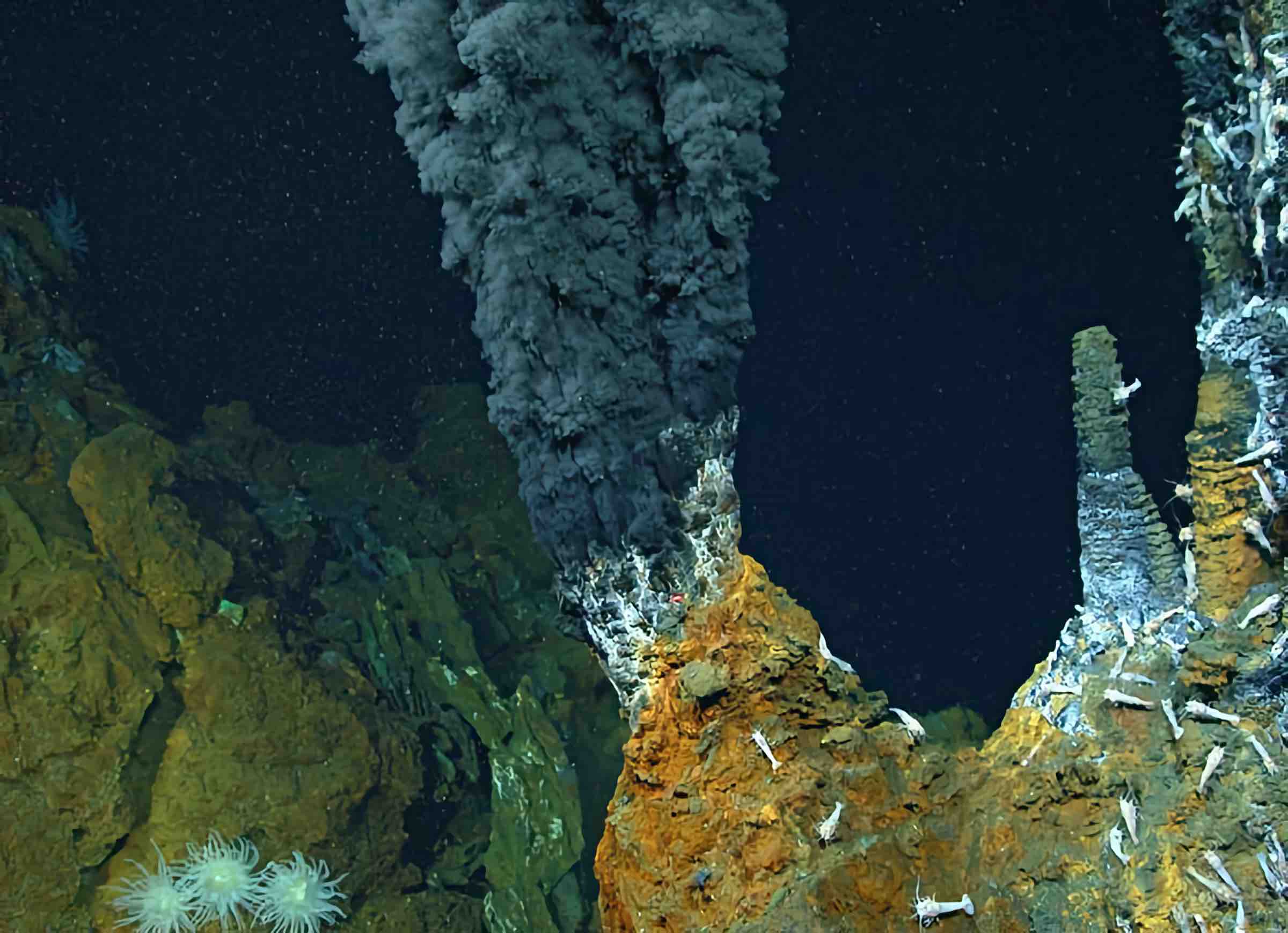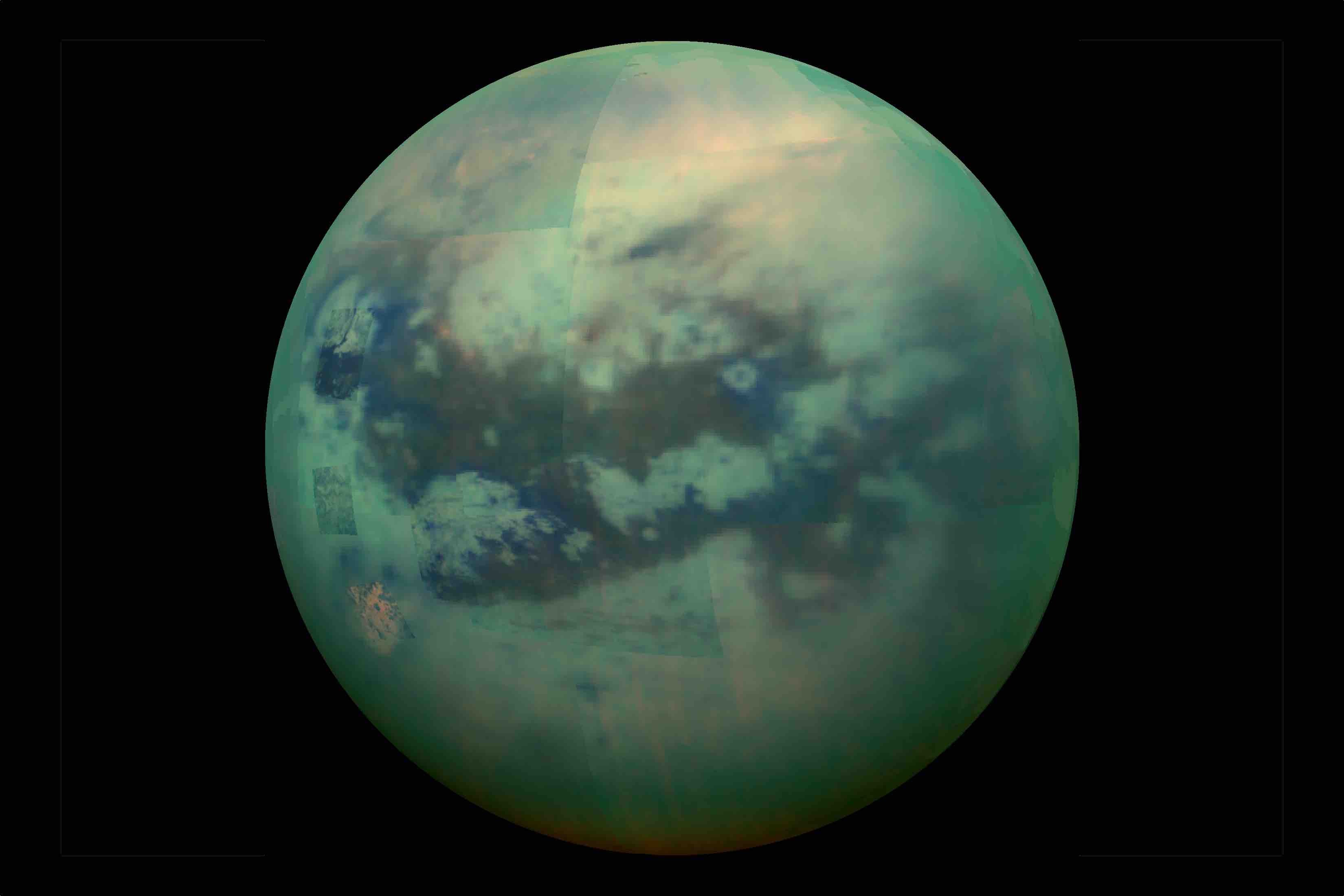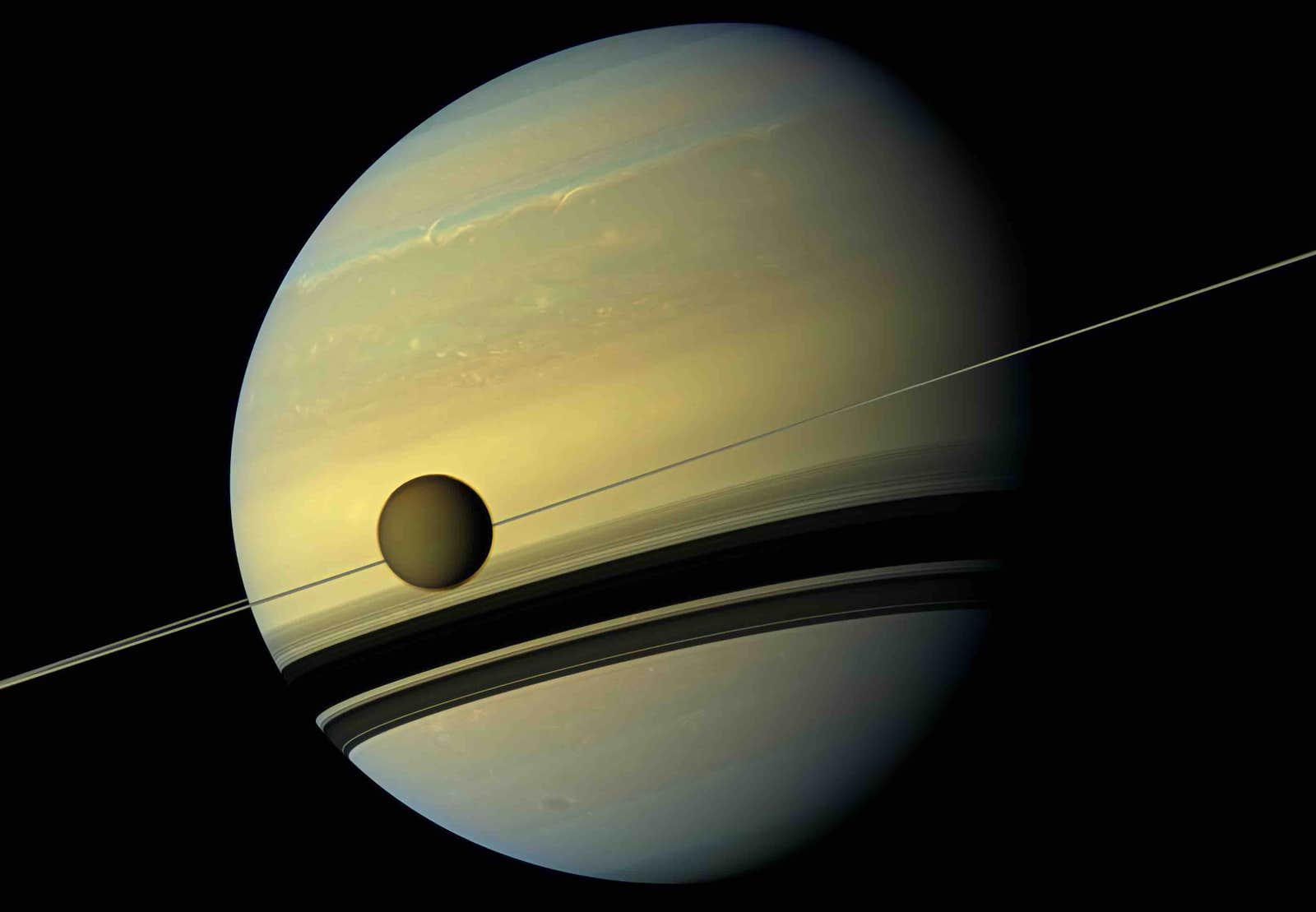In the mid-2020’s, NASA will launch a helicopter-like lander the size of a small car toward Titan, Saturn’s largest moon. Nearly a decade later, after crossing about a billion miles of empty darkness, this spacecraft, dubbed Dragonfly, will gently settle onto Titan’s sand dunes. There the sun will merely appear as a very bright star in the heavens and the Earth will barely be visible, like a floating mote of dust. The frigid temperatures will be colder than anywhere on Earth. But scientists believe this enigmatic world might harbor alien life.
Of all the planets, moons and asteroids in our solar system, Titan is a rarity. Along with Enceladus, another of Saturn’s moons, and Europa, which orbits Jupiter, it is an ocean world, possessing flowing water and other liquids, organic materials, and an energy source that could provide just the right conditions for microbes to arise. Mars might be synonymous with pop-culture conceptions of aliens, but the Red Planet likely lacks those features and has been bone-dry and mostly atmosphere-less for some three billion years. These ocean worlds could be inhabited right now.
The discovery of any kind of alien microbes on any of these worlds would be transformative, changing our prevailing views of life, its origins, and ultimately, ourselves. But if searches for life continue to turn up nothing, it may turn out that Earthlings have to explore much, much further to find fellow organisms in our galaxy.
“These three moons in particular can help us test the hypothesis of whether life can naturally evolve in a place if you have all the ingredients it needs to survive,” says Morgan Cable, an astrochemist at Jet Propulsion Laboratory and part of a cadre of astronomers who want to send robotic explorers to these moons. “Or is life super unique and we’re horribly alone?”
Along with Dragonfly, NASA is also building the Europa Clipper, a spacecraft slated to sail toward Jupiter’s moon in the near future. And though a return to Enceladus is not high on the agency’s priorities, a collaboration with the Breakthrough Starshot Foundation could eventually get a mission off the ground. Titan will come first, though, making it the first ocean world—other than Earth, of course—to be explored.
Titan will be the first ocean world—other than Earth—to be explored.
Sometimes visible to the naked eye with its faint yellowish hue, Saturn has fascinated Persian, Hindu, Chinese, Greek and other stargazers for millennia. But it was Dutch astronomer Christiaan Huygens who discovered Titan orbiting the sixth planet in 1655 using a telescope he built himself. Soon afterward, he discerned Saturn’s rings and also spotted a clutch of its smaller moons, of which there are now known to be more than fifty. Huygens referred to the largest moon as Luna Saturni, and English astronomer John Herschel later gave it and other known moons names from Greek mythology. Those monikers stuck.
In the 1980s, data collected by the first Voyager probe during its brief, 37,000 mile-per-hour flyby revealed how surprisingly thick and opaque Titan’s atmosphere is. Later came NASA’s Cassini spacecraft, laden with sensitive instrumentation, which surveyed the ocean worlds and other moons until spectacularly ending its mission in 2017 by diving into Saturn’s gaseous body. Before Cassini burned up, the data it sent back to Earth finally penetrated Titan’s haze to map out its undulating plains, dunes, lakes, and craters.
Larger than our moon and even Mercury, which is roughly two-fifths the size of Earth, Titan hosts plenty of intriguingly unique environments. Nascent lifeforms might benefit from its bubbling ice volcanoes, with the heat and pressure from below thrusting up liquified, briny ice like flowing, molten rock on Earth. And Titan is occasionally bombarded by asteroids whose impacts could melt the ice frozen on its surface. But after a time the water they produce—and anything possibly living there—would inevitably freeze again.

Titan’s dense, calm, orange-tinted atmosphere stands out, too, as an uncommon feature of worlds in our solar system. “The reason we’re interested in life on Titan is because of its atmosphere,” says Catherine Neish, a planetary scientist at the University of Western Ontario. Nitrogen and other molecules undergo reactions with ultraviolet light from the sun and cosmic rays, which turns them into more complex molecules. “At the end of the day,” says Neish, “you have these hugely complicated organic molecules that slowly trickle down to the surface, meaning that the Titan surface is covered in them.”
The chemical conditions on the surface could pose an obstacle to possible fledgling microbes—provided they’re like anything scientists know on Earth. But scientists have also speculated about life as we don’t know it. Clouds of methane and ethane drift over Titan; they rain onto its surface, forming rivers and streams that ooze into polar seas comparable in size to the Great Lakes on Earth. It’s the only world in the solar system other than Earth known to have vast quantities of liquid on its surface.
Liquids are a superb medium for bringing molecules together, forming new ones, and sweeping away waste. Eventually, somewhere, molecules can become more complex and make new copies of themselves, crossing the blurry boundary that some scientists and philosophers would call “life.” The methane lakes of Titan would offer very different building blocks than do Earth’s pools; microbes would have to eat acetylene and breathe hydrogen rather than oxygen, and exhale methane instead of carbon dioxide.
These alien life forms would also need to cope with temperatures down to −180 degrees Celsius—roughly twice as cold as the coldest temperature ever recorded on Earth—and with methane being a poor medium for carbon-based organic molecules to dissolve in. That would limit the chemical possibilities, making it harder to break most chemical bonds, and crucially, it would result in slower chemical reactions. If microbes defied the odds and arose on the surface, then, their life cycle and ecological interactions would move very slowly compared to the processes thought to be involved in the beginnings of life on Earth.
Scientists are keeping an open mind about life’s myriad forms, including a chemistry alien to us, so they equip their probes with a variety of instruments and make their explorations as thorough as possible. But it’s hard to look for something you’ve never seen before. “It may be that life in a lake like that is very, very different and potentially unrecognizable compared to life as we know,” says Cable. “We don’t want to miss it by accident because we’re biased by Earth life.”

Methane lakes are not the only potential cradle for Titanian life. Titan, as well as Europa and Enceladus, have relatively warm oceans underground. Titan’s salty waters are hidden beneath an icy crust 100 kilometers thick, blocking already-feeble light from the distant sun, so photosynthesis would be impossible. But it is possible that on some of the ocean worlds, alien microbes could instead glean energy from hydrothermal—hot water—vents found near volcanoes rising from the bottom of these vast oceans.
On Earth, the movement of tectonic plates cracks the planet’s rocky crust and creates such fissures. On the ocean worlds, the necessary force is provided by the constant gravitational pull of close orbits around the colossi of Saturn and Jupiter. Water percolating into cracking rock can then release energy.
“The great thing about hydrothermal vents is that they provide a lot of energy sources for microbial life that doesn’t include sunlight,” says Julie Huber, a marine chemist at Woods Hole Oceanographic Institution. Organisms living at hydrothermal vents on Earth’s seafloors, she explains, “can use chemical energy, so that means things like sulphur, iron, hydrogen and methane and they create a base of the food chain.”
In the mid-1970s, oceanographers towing cameras on miles-long cables through the Galápagos Rift in the Eastern Pacific Ocean, near the islands of the same name, collected the first clear evidence of hydrothermal vents. They’ve subsequently been found scattered in seafloor volcanic areas near the edges of tectonic plates throughout the world’s ocean, spewing superheated, mineral-rich fluids that generate chemical reactions as they burble into the cold seawater.
It might seem challenging for anything to subsist in these harsh, bleak places. In fact, such environments typically offer wide ranges of temperature, pressure, acidity and energy, meaning that a diversity of microbial life is actually possible. It’s been theorized that life on Earth actually originated around hydrothermal vents rather than in primordial soup at the planet’s surface, and some hardy organisms thrive there: mainly specially adapted bacteria and single-celled creatures known as archaea. Even in the ostensibly deadest spot on Earth, the nutrient-starved South Pacific Gyre east of Australia, scientists recently found microbes that apparently survived for millions of years in a form of stasis while embedded in the seafloor.
Vent fields off Costa Rica and in the Caribbean’s deep Cayman Trough are thought to be similar an undersea spot on Enceladus, and the connection between hydrothermal vents on Earth and potentially similar spots on ocean worlds has spurred collaborations between astrobiologists and oceanographers like Huber. The nascent deep-sea mining industry is interested, too, though for different reasons: the mineral-rich sulfide deposits include some valuable metals in dwindling supply on land, like manganese, copper, nickel and cobalt, some of which are necessary for building electronics, including mobile phones.
A few companies have already made successful attempts to mine some shallower spots, but their expensive efforts haven’t yet turned a profit. No company is mining hydrothermal vents or disturbing their fragile ecosystems yet, Huber says, but they’ve considered it. Seafloor miners will surely continue with their plans, yet considering that active hydrothermal systems add up to only a few square kilometers, and that they might hold keys to understanding life’s origins here or on alien worlds, the industry should follow the recommendations of marine biologists and consider the areas off limits. Perhaps in a few decades, potential off-world mining spots will need similar protections.

Titan’s ocean seems to be sandwiched between two thick layers of ice; it might not actually be in contact with the rocky layer that surrounds the moon’s molten iron core, and therefore might not have hydrothermal vents. But within the upper ice shell itself, liquid pockets between grains of ice might be favorable homes for life. “It’s really cool to think about: this apparently uniform block of ice might have these tiny microenvironments, all different and diverse, and you could have different microbes and bacteria in each one of them,” says Michael Malaska, a Jet Propulsion Laboratory planetary scientist.
New research by Malaska’s colleagues show that organic material-laden comets were likely involved in Titan’s tumultuous assembly billions of years ago, or it may have been hit by comets later on. In any case, it formed from bits of rock, ice, and a huge amount of organic material—more than its fellow ocean worlds—which was all cooked up inside it. Gases bubbled out in the process, especially nitrogen, forming the thick, protective atmosphere we see today. And its ice is probably thoroughly infused with organics that microbes would love to munch on.
Below Titan’s chilly surface, about 15 to 20 kilometers down into the ice but above the interface with the ocean, could have just the right physical and chemical conditions, Malaska argues. There ice flows in extremely slow motion, like a glacier, making it a slightly warmer environment, though still below freezing. When ice grains form, everything that’s not ice is pushed out in concentrated spots. That includes trace amounts of chemical compounds like acetylene that make chemical reactions known as “redox”—short for reduction-oxidation, when molecules transfer electrons and release energy—possible. Redox reactions are an important way to generate energy, and they’re the basis of photosynthesis and other life processes.
To sustain the reactions across evolutionary time, organic material beneath the ice needs to be replenished. Provided that enough of them somehow make their way through the ice to the underground pockets, organics scattered on the surface would do the trick. On Earth, those organic molecules fascinated Carl Sagan so much that he named them—“tholins,” following the Greek word that means both “mud” and “dome.” Dissolving tholins in water yields amino acids, the building blocks of proteins and of life. If they’re getting to the right places, alien microorganisms could be feeding on them right now.
Malaska and colleagues have drilled cores deep into the Greenland ice cap and in Antarctica, which some scientists consider to be rough analogues for Titan’s ice layers. They’ve found them to be chock full of life. Bacteria and other microbes live just fine in those subzero environments. Scientists have already found bacteria that eat acetylene, too—so if microbes can do that, survive in the cold, and handle the high pressure of Titan’s miles-thick ice, they’ll have all they need.
All this means we should have a broader view of the “habitable zone” around stars. Astronomers typically use that concept to refer to the range of worlds that could have liquid water on their surface. Too far away and it’s too cold, so it’s all frozen; too close and it’s so hot that any water quickly evaporates away. In our system, that Goldilocks range spans from about Venus to Mars, but neither of those planets are actually habitable today. Instead we have a motley variety of ocean worlds well outside that zone.
In the 1960s, American astronomer Frank Drake and his colleagues began speculating about the probabilities of life on planets in the Milky Way. Their work culminated in the Drake equation, an estimate of how many extraterrestrial civilizations could exist in our galaxy. Many of the variables involved were wildly uncertain or mostly unknown at the time, but in the early 2000s NASA’s Kepler space telescope, named after the 17th century German astronomer, revolutionized astrobiology.
Using its sensitive cameras, astronomers discovered thousands of planets revolving around different types of stars. They likely represent just a tiny fraction of all the planets in our galaxy. Some of those planets are rocky worlds in their stars’ habitable zones, like the Earth’s distance from the sun. But the search for life shouldn’t stop there. The life-friendly conditions on Titan and other ocean worlds suggest that the odds of life evolving elsewhere are even higher than was thought—and our promising ocean worlds just scratch the surface of planetary variety. There could be thousands or more planets and moons populated by aliens in the Milky Way.
“We’re finding a lot of variation in the types of planets, their orbits, and the kinds of resources they could hold,” Cable says. “By studying our solar system, our cosmic backyard, we’re getting a little taste of that diversity of worlds as we start to reach beyond it.”
While a long-distance call with intelligent aliens would be earth-shattering, the discovery of any alien life, even just microbes, could inspire a massive shift in our worldview. For millennia, people believed that the universe revolves around the Earth, or at least that Earthly life is totally unique. Nowadays we just don’t yet know if our nearest extraterrestrial neighbors orbit the same sun or if they are light years away.
“When you have only one example of the biochemistry of life, it’s hard to generalize.”
Discovering alien microbes could also illuminate questions about the time scales required for life to arise. On Earth, it took up to a billion years; Titan, Europa, Enceladus, being multiple billions of years old, ought to be old enough. Or we might find evidence that life evolved and then died off, which would pose its own sets of questions and answers. Exploring the ocean worlds could also help explain the origins of life on our own world, which might have emerged around a hydrothermal vent in our ancient oceans or in the middle of a slab of ice.
Even if alien microbes do reside on Titan or another ocean world, though, actually detecting them could be an extremely difficult task. “When you don’t know what the biology is, you really want to look for patterns,” says Jonathan Lunine, a planetary scientist at Cornell University. Structures of complex molecules unlikely to arise through inert processes, or an abundance of some carbon isotopes and a lack of others, or some version of amino acids, proteins or nucleic acids, could all be positive signs of life. “It’s really a guessing game. When you have only one example of the biochemistry of life, on Earth, it’s hard to generalize,” he says.
The only way to have a shot at knowing for sure is to go there. Telescopes can only peer so far toward through Titan’s atmosphere, and the journey is still too difficult for astronauts. Thus Dragonfly, with its eight rotors and helicopter-style skids, will set forth. Once it arrives on Titan, it will hop and soar from site to site, exploring the moon’s varied terrains. It will scoop up ice and rock and whatever other material it can find and feed it into its instruments, while probing the moon’s interior. At the end of its mission it might even be able to reach the methane lakes at Titan’s poles, though navigating their steep, clifflike shores could prove difficult.
If we’re lucky, this robotic emissary will make first contact with a tiny alien.
Lead image: A real-color image of Titan in orbit around Saturn. The dark black bands are shadows cast by Saturn’s rings. CREDIT: NASA/JPL-Caltech/Space Science Institute
Video: Animation of the Dragonfly lander’s approach to Titan. CREDIT: NASA































